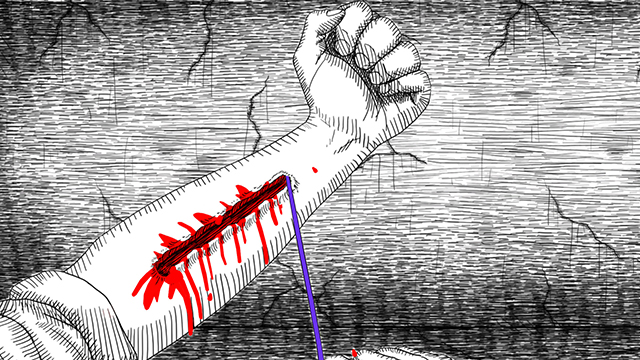“Waking up is a strange reason to die.”
Descending into another person’s psyche is one of my favorite aspects that video games possess. In some games, this manifests in unchained art styles or off-kilter narratives. When it comes to horror, though, venturing deeper and deeper in makes you equally fear what is in your own mind as what is in that of the creator. Neverending Nightmares was born from Matt Gilgenbach’s mind, inspired by his own personal struggles with depression and obsessive compulsive disorder (OCD).
The journey that results is not so much scary as it is an intense reflection of our own fears and woes.
The player controls Thomas, a presumably teenage boy who wakes up after a frightening vision of a girl bleeding to death. Waking up is the basic tenet of how this horror works. Thomas explores the many long hallways and rooms of each level, and each harbors the potential for death. Embracing the recent trends in horror, the game has Thomas be essentially powerless against those that would seek him harm, so enemies must be avoided… sort of.
When Thomas is brutally murdered, he will wake up in a nearby bedroom. But sometimes he must be eviscerated to continue his journey. Thus, the title breathes life into the gameplay—you are rarely aware of whether you’re making progress or set back except for a few key moments when the scene takes a different tone. Something I appreciated is that deaths are always uncomfortable and visible. Thomas doesn’t have a health bar that dwindles until he passes out, and all the foes he faces are solely interested in bloodletting.
Blood is quite noticeable and takes on its own persona in Neverending Nightmares. Eschewing hyper-realism completely, the visuals appear to take a page from an Edward Gorey book. The majority of objects and characters are all in black and white, darkness being portrayed through extreme cross hatching. Only interactive objects are in color, and blood is a bright red. Through each segment of the nightmare, you’ll progressively see blood splattered in increasing amounts, occasionally accompanied by viscera and offal.
Oddly, the more gore you witness, the more progress you make in the game. Levels take you through overly elaborate houses, hospitals, and forests that become increasingly dark and disarrayed in addition to bloody. As Thomas advances, the phenomenal sound design continues to haunt the player. It’s not just the music that gets moody; voices echo, strange ignorable noises become louder, and intense soundscapes overtake the audio entirely. This all seems par for the course, but in this game you need to hear it to believe it. There’s even a special setting for headphones to enhance the experience.
When the silence returns, you’ll know you’re getting somewhere, but in some ways, it feels like you’ve lost your only friend in this hell. A constant has been removed, and you can no longer rely on it. Objects also seem to move about, and the game plays tricks on you—you’ll see shadows shift in the corner of your eye, and paintings will rearrange themselves on the walls while you enter rooms. Because you spend so much time just walking, it’s hard to tell if you should follow spooky apparitions—yet another way the game tries to fool you.
The immersion can be so great that the aspects which break it are especially damning, not in that good horror way. Apparently, one of the Kickstarter backer rewards was for a portrait of the backer to be placed in game. Sure enough, there are a number of these with colored frames. As I mentioned earlier, colored objects are interactive, but when you interact with these portraits, you just see them in greater detail.
Whereas other objects you can inspect are eviscerated animals, sinks full of teeth and blood, or creepy dolls, these portraits don’t add to the narrative. There are plenty of odd and haunting paintings that you cannot interact with, and these should’ve been like that. It’s a small complaint because you eventually learn to ignore them, but it’s sad to include something in a game to be ignored. Everything should have a purpose within the narrative, especially for horror.
Ultimately, the portrayal of depression and OCD is highly successful, but I don’t know if people who are not attuned to such things will fully appreciate this. This is not a criticism because I think this experience has universal appeal to horror lovers. However, those who know something about and sympathize with debilitating mental conditions will understand aspects of the experience more. The visuals and triggered events, which I won’t spoil, really convey disturbing themes of self-harm, self-blame, guilt and shame associated with therapy, and the extent to which someone with OCD might go to create “balance.”
While I do believe some players may dismiss the game as a “walking simulator” (as they are wont to do nowadays), Neverending Nightmares falls into the must-play section of the horror genre. Whether or not you find it scary, you’ll definitely be disturbed and intrigued as you seek resolution to the madness. There are also branching paths, something the game will point out, but the actions or lack thereof Thomas must take to find them are elusive and will keep players guessing. Get used to the blood.
-
Well-portrayed themes of depression and OCD
-
Visuals reminiscent of Edward Gorey
-
Phenomenal sound design
-
Effectively disturbing horror experience
-
Needless interactive portraits break immersion
-
Plodding walking pace may scare some players away
Neverending Nightmares
-
Neverending Nightmares #1

-
Neverending Nightmares #2

-
Neverending Nightmares #3

-
Neverending Nightmares #4

-
Neverending Nightmares #5

-
Neverending Nightmares #6












